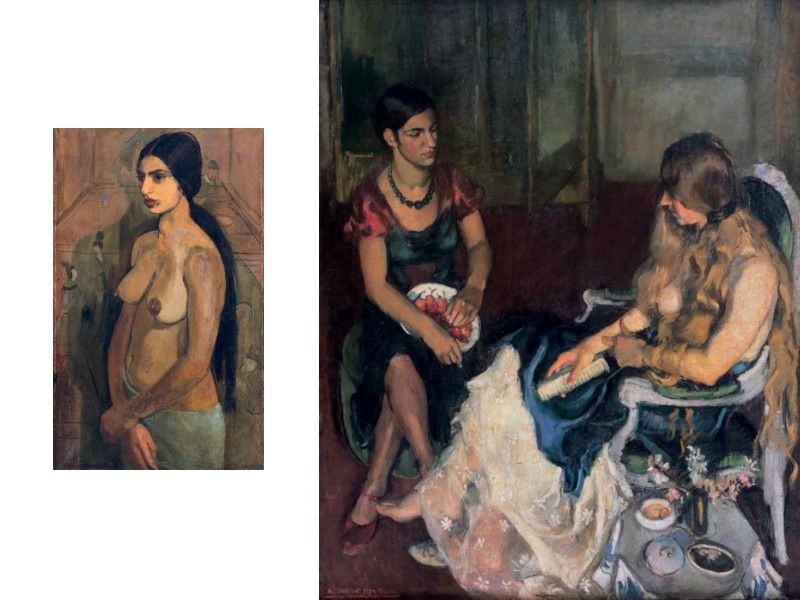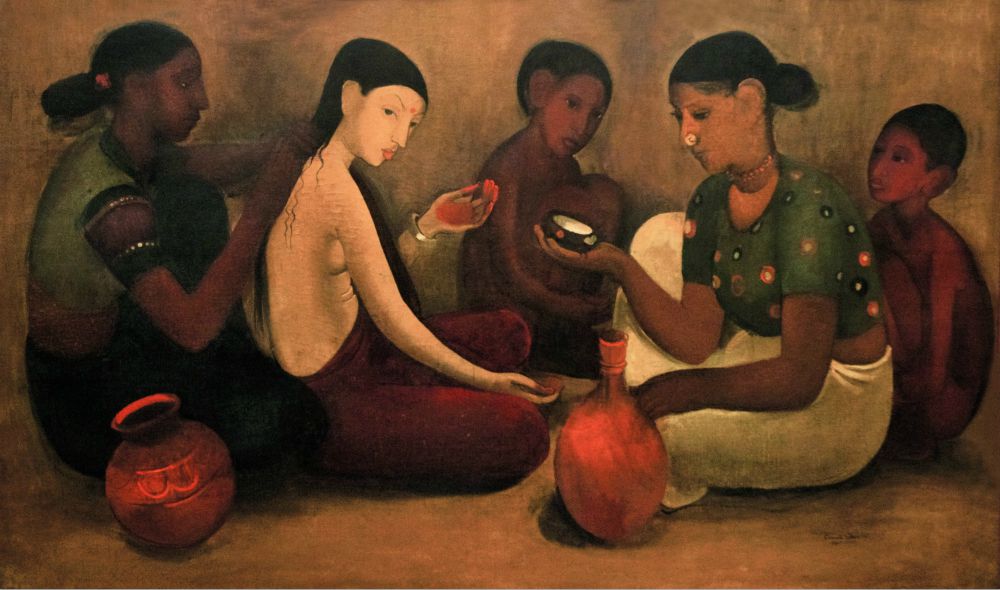We use cookies to optimise our website functionality and give you the best experience possible. Please, accept our Terms and Conditions. ACCEPT
The mother of Indian modern painting
Amrita Sher-Gil, a pioneer of modern Indian art, used her paintbrush to depict the daily lives of Indian women in the 1930s, often revealing a sense of their loneliness and even hopelessness. She painted women going to the market, women at a wedding, women at home. Sometimes she showed women bonding with other women. At times the works seemed to convey a sense of silent resolve. It was a rendering rarely seen in depictions of Indian women at the time, when portrayals tended to cast them as happy and obedient.
The melancholic painting “Three Girls” for instance, shows women wearing passive expressions, their solemn brown faces a contrast to the vibrant reds, greens and ambers of their clothing. The mood is despondent, as though the women are waiting for something they doubt will ever come along.With her style and her emphasis on women, Sher-Gil became known as the “Indian Frida Kahlo.”
"Europe belongs to Picasso, Matisse and many others, India belongs only to me." Amrita Sher-Gil
Amrita Sher-Gil (January 30, 1913 – December 5, 1941), an eminent Indian painter, was the daughter of Sardar Umrao Singh Shergil and Antoinette, a Hungarian lady. Her first notable work was "Young Girls", which made her an Associate of the Grand Salon in Paris in 1933; she was the youngest ever Asian to receive this recognition. Her quest for the rediscovery of the traditions of Indian art began at an young age but was cut short by her death at a prime age of 28. Mughal school of painting and Pahari schools of painting and the cave paintings at Ajanta greatly influenced her paintings. She was considered a prominent woman painter of 20th century India. Her legacy is comparable to that of the Masters of Bengal Renaissance. The Government of India has declared her works as National Art Treasures. She was sometimes called as India's Frida Kahlo.
She understood the loneliness of her subjects well, since their moods were a reflection of her own. Because of her upbringing, she lived between worlds, often searching for a sense of belonging.
Sher-Gil was born in Budapest on Jan. 30, 1913, to the Hungarian-Jewish opera singer Marie Antoinette Gottesmann and Umrao Singh Sher-Gil Majithia, a Sikh aristocrat and a scholar of Persian and Sanskrit. She began taking formal art lessons at age 8, when her family moved to Summer Hill, Shimla, in northern India.
At 16, she moved to Paris and continued studying art, first at the Académie de la Grande Chaumière and later at the École des Beaux-Arts. She had early success.
Her 1932 painting “Young Girls” received a gold medal in 1933 at the Paris Salon, the renowned art show. It depicts her sister, Indira, wearing European clothing and a look of confidence while sitting with a partially undressed friend, Denise Proutaux, whose face is obscured by her hair - one woman bold and daring and another reserved and hidden. The painting reflects the different aspects of Sher-Gil’s personality - outgoing and sociable, as she was known among those who encountered her at Parisian parties, or tucked away and painting vigorously.
In addition to paintings of relatives, lovers and friends, she created self-portraits that showed her “grappling with her own identity,” one of her biographers, Yashodhara Dalmia, wrote in “Amrita Sher-Gil: A Life” (2006).
 ©
AMRITA SHER-GIL
©
AMRITA SHER-GIL
“Everybody says that I have improved immensely; even that person whose criticism in my view is most important to me - myself.” Amrita Sher-Gil
They often reflected an introverted and troubled woman caught between her Hungarian and Indian existences. “Self Portrait as Tahitian” evokes the style of the French post-Impressionist Paul Gauguin, who often painted dark-skinned Tahitian women. Her own brown body is painted in Gauguin’s stylization of the female nude, with a plain ponytail and distant, somber expression on her face.
Sher-Gil also felt conflicted about her sexuality. She was drawn to the idea of a lesbian affair, Dalmia wrote, “partly as a result of her larger view of woman as a strong individual, liberated from the artifice of convention.” She formed a strong bond with the painter Marie Louise Chassany, and some art critics - including her nephew, the artist Vivan Sundaram, who also wrote a biography of her - believed her piece “Two Women” reflected their longing for one another.
At one point her mother asked about the nature of their relationship, according to the book “Same-Sex Love in India” (2000), by Ruth Vanita and Saleem Kidwai. Sher-Gil denied intimacy with Chassany in a 1934 letter to her mother - translated from Hungarian for Vanita and Kidwai’s book. Though she cited the “disadvantages of relationships” with men, she said of Chassany: “We never had anything to do with each other in sexual terms.” She added: “I thought I would start a relationship with a woman when the opportunity arises.”
She did, in fact, have relationships with men, seeing marriage as a way to gain independence from her parents. In 1938, she married a cousin, Victor Egan, revealing only afterward that she was pregnant. He arranged for an abortion.
Despite being acclaimed for her work, Sher-Gil felt unfulfilled in Paris. She wrote that she was “haunted by an intense longing to return to India, feeling in some strange inexplicable way that there lay my destiny as a painter.”
She went back in 1935, and found the inspiration she needed as she traveled around the country and reconnected with its people. Her family had close ties to the British Raj, but she sympathized with the Indian National Congress, which had been fighting for the rights of average Indians who sought independence from Britain.
She described her technical style during this period as becoming more “fundamentally Indian.”
 ©
AMRITA SHER-GIL
©
AMRITA SHER-GIL
“I realized my artistic mission then: to interpret the life of Indians and particularly of the poor Indians pictorially, to paint those silent images of infinite submission and patience, to depict their angular brown bodies.” Amrita Sher-Gil
In 1939, Sher-Gil and Egan ultimately settled in Saraya, a village in India’s Gorakhpur district. She was depressed while living there. After a time, she and Egan decided to relocate to Lahore, a growing cultural center in India that is now part of Pakistan. Days before her first significant solo art show in Lahore, she became ill.
Sher-Gil died on Dec. 5, 1941. The cause was believed to be complications from a second, failed abortion performed by Egan, Dalmia wrote in her biography of Sher-Gil. She was 28 and was just gaining widespread popularity and taking on commissions.
Sher-Gil’s legacy has grown in recent years. Unesco, the cultural organization of the United Nations, declared 2013, the 100th anniversary of her birth, the international year of Amrita Sher-Gil.
“I painted a few very good paintings,” she wrote in a letter to her mother in October 1931, when she was 18. “Everybody says that I have improved immensely; even that person whose criticism in my view is most important to me - myself.”

Museum of Goa (MOG) is a private contemporary art space. Founded by Dr. Subodh Kerkar in 2015, the Museum celebrates Goa’s history and people through contemporary art.

Medical professional who gave up medicine to pursue arts 30 years ago. He has carved a niche for himself, especially in the field of conceptual art and land art. He is the founding director of Museum of Goa.